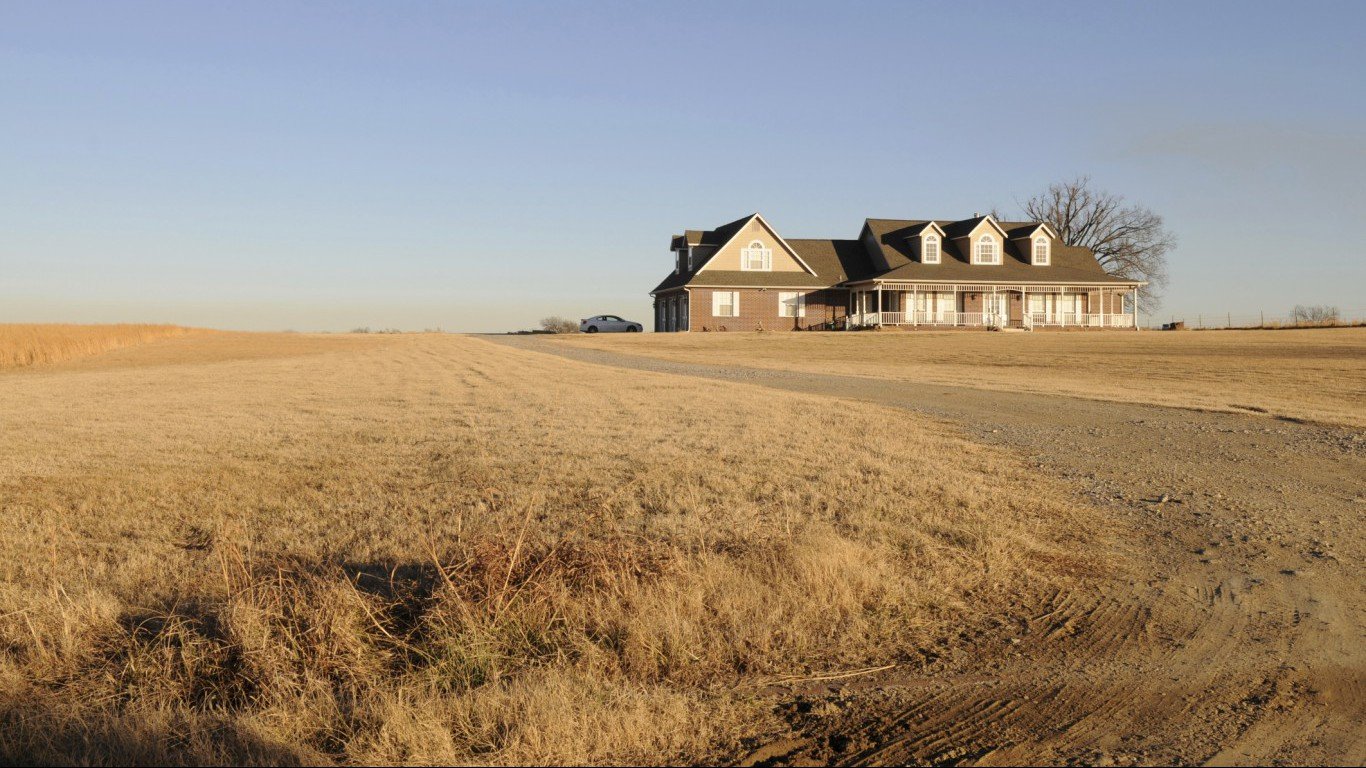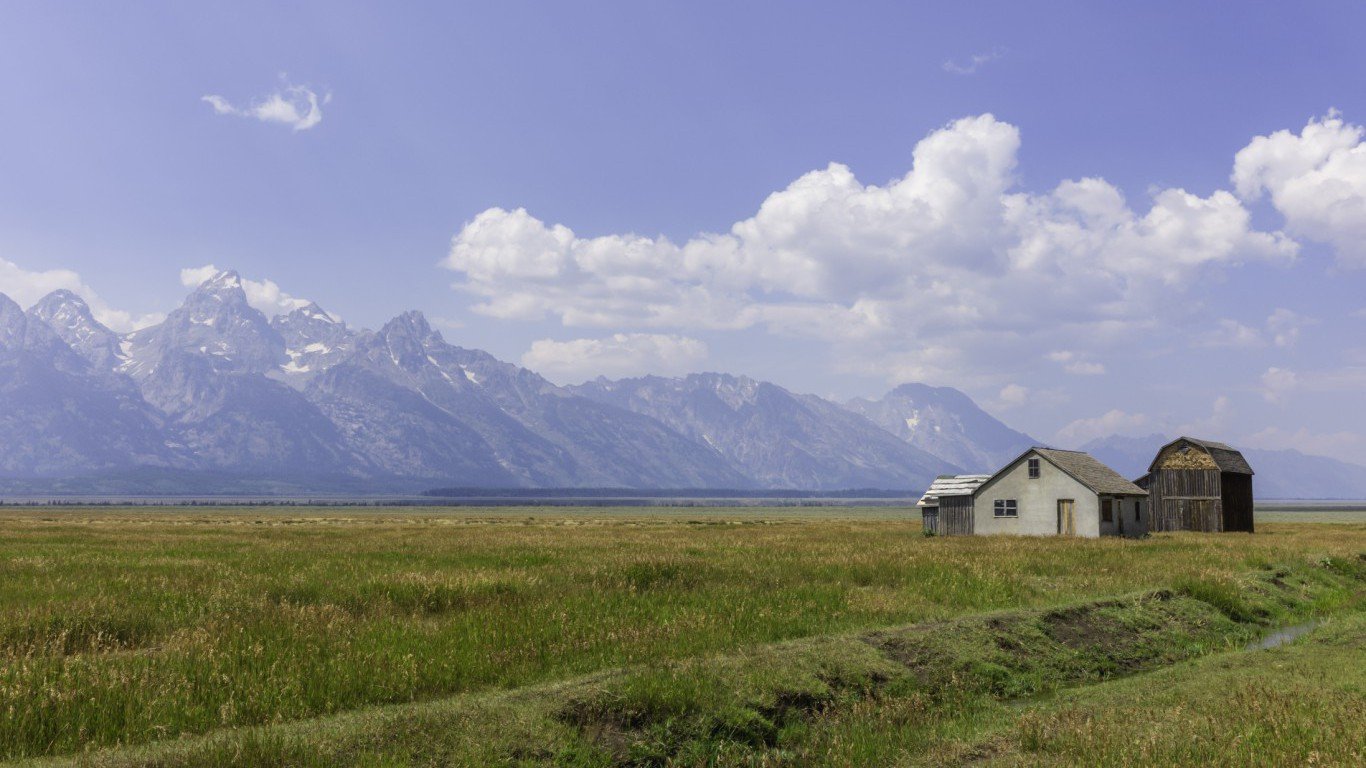Special Report
Worst States for Women

Published:
Last Updated:

Women have made big strides in their quest for gender equality, but there is much to do, as the rise of the #MeToo and Times Up movements indicate.
Sexual harassment at work is but one of the issues at the heart of gender inequality in the United States. Other issues are the gender pay gap, a lack of flexibility in the workplace during pregnancy and early motherhood, a relative lack of women in managerial positions, and a dearth of women holding positions of political influence.
Though no state has achieved gender pay equity, many have made progress in closing the earnings gap, improving in other areas, such as funding pre-K programs, passing laws that make it easier for women to stay in the workforce when they have children, and electing women to office.
Even so, some states remain unfavorable to women in every major category. 24/7 Wall St. reviewed and ranked from best to worst all 50 states based on measures of gender equality in three main areas: economy, leadership, and health. Each category consists of several measures, from gender pay gap to the percentage of women in management roles to the percentage of women who lack health insurance.
Click here to see the worst states for women.
Click her to see our detailed findings and methodology.

1. New York
> Female earnings as pct. of male: 88.6% (the highest)
> Pct. mgmt. jobs held by women: 41.1% (8th highest)
> Pct. 3-4 yr. olds enrolled in state pre-K: 26.5% (9th highest)
> Pct. legislative seats held by women: 28.2% (19th highest)
[in-text-ad]

2. California
> Female earnings as pct. of male: 88.3% (2nd highest)
> Pct. mgmt. jobs held by women: 39.0% (22nd highest)
> Pct. 3-4 yr. olds enrolled in state pre-K: 23.7% (12th highest)
> Pct. legislative seats held by women: 24.2% (22nd lowest)

3. Oregon
> Female earnings as pct. of male: 79.3% (23rd highest)
> Pct. mgmt. jobs held by women: 39.6% (16th highest)
> Pct. 3-4 yr. olds enrolled in state pre-K: 10.0% (23rd lowest)
> Pct. legislative seats held by women: 33.3% (8th highest)

4. Vermont
> Female earnings as pct. of male: 85.5% (4th highest)
> Pct. mgmt. jobs held by women: 42.6% (3rd highest)
> Pct. 3-4 yr. olds enrolled in state pre-K: 67.5% (the highest)
> Pct. legislative seats held by women: 40.0% (the highest)
[in-text-ad-2]

5. Rhode Island
> Female earnings as pct. of male: 81.5% (17th highest)
> Pct. mgmt. jobs held by women: 38.3% (22nd lowest)
> Pct. 3-4 yr. olds enrolled in state pre-K: 4.6% (17th lowest)
> Pct. legislative seats held by women: 31.9% (11th highest)

6. Hawaii
> Female earnings as pct. of male: 82.2% (10th highest)
> Pct. mgmt. jobs held by women: 41.1% (8th highest)
> Pct. 3-4 yr. olds enrolled in state pre-K: 1.0% (8th lowest)
> Pct. legislative seats held by women: 28.9% (16th highest)
[in-text-ad]

7. Connecticut
> Female earnings as pct. of male: 78.5% (23rd lowest)
> Pct. mgmt. jobs held by women: 37.8% (18th lowest)
> Pct. 3-4 yr. olds enrolled in state pre-K: 19.4% (18th highest)
> Pct. legislative seats held by women: 27.3% (21st highest)

8. New Jersey
> Female earnings as pct. of male: 80.9% (19th highest)
> Pct. mgmt. jobs held by women: 38.6% (25th highest)
> Pct. 3-4 yr. olds enrolled in state pre-K: 25.3% (10th highest)
> Pct. legislative seats held by women: 30.8% (13th highest)

9. Maine
> Female earnings as pct. of male: 83.8% (6th highest)
> Pct. mgmt. jobs held by women: 43.3% (the highest)
> Pct. 3-4 yr. olds enrolled in state pre-K: 19.4% (18th highest)
> Pct. legislative seats held by women: 33.9% (7th highest)
[in-text-ad-2]

10. Minnesota
> Female earnings as pct. of male: 82.7% (9th highest)
> Pct. mgmt. jobs held by women: 37.3% (16th lowest)
> Pct. 3-4 yr. olds enrolled in state pre-K: 3.3% (15th lowest)
> Pct. legislative seats held by women: 32.3% (10th highest)

11. New Hampshire
> Female earnings as pct. of male: 83.1% (8th highest)
> Pct. mgmt. jobs held by women: 37.2% (14th lowest)
> Pct. 3-4 yr. olds enrolled in state pre-K: N/A
> Pct. legislative seats held by women: 28.8% (17th highest)
[in-text-ad]

12. New Mexico
> Female earnings as pct. of male: 82.1% (11th highest)
> Pct. mgmt. jobs held by women: 41.7% (5th highest)
> Pct. 3-4 yr. olds enrolled in state pre-K: 19.8% (17th highest)
> Pct. legislative seats held by women: 30.4% (15th highest)

13. Washington
> Female earnings as pct. of male: 75.0% (9th lowest)
> Pct. mgmt. jobs held by women: 38.4% (25th lowest)
> Pct. 3-4 yr. olds enrolled in state pre-K: 6.4% (19th lowest)
> Pct. legislative seats held by women: 37.4% (5th highest)

14. Illinois
> Female earnings as pct. of male: 78.8% (24th lowest)
> Pct. mgmt. jobs held by women: 39.3% (19th highest)
> Pct. 3-4 yr. olds enrolled in state pre-K: 23.2% (13th highest)
> Pct. legislative seats held by women: 35.6% (6th highest)
[in-text-ad-2]

15. Massachusetts
> Female earnings as pct. of male: 81.8% (13th highest)
> Pct. mgmt. jobs held by women: 41.5% (7th highest)
> Pct. 3-4 yr. olds enrolled in state pre-K: 6.7% (20th lowest)
> Pct. legislative seats held by women: 24.5% (23rd lowest)

16. Colorado
> Female earnings as pct. of male: 84.2% (5th highest)
> Pct. mgmt. jobs held by women: 38.4% (25th lowest)
> Pct. 3-4 yr. olds enrolled in state pre-K: 15.7% (22nd highest)
> Pct. legislative seats held by women: 38.0% (4th highest)
[in-text-ad]

17. Maryland
> Female earnings as pct. of male: 83.4% (7th highest)
> Pct. mgmt. jobs held by women: 42.8% (2nd highest)
> Pct. 3-4 yr. olds enrolled in state pre-K: 21.1% (15th highest)
> Pct. legislative seats held by women: 32.4% (9th highest)

18. Delaware
> Female earnings as pct. of male: 81.8% (13th highest)
> Pct. mgmt. jobs held by women: 42.2% (4th highest)
> Pct. 3-4 yr. olds enrolled in state pre-K: 3.8% (16th lowest)
> Pct. legislative seats held by women: 21.0% (17th lowest)

19. Florida
> Female earnings as pct. of male: 86.9% (3rd highest)
> Pct. mgmt. jobs held by women: 40.3% (14th highest)
> Pct. 3-4 yr. olds enrolled in state pre-K: 38.9% (2nd highest)
> Pct. legislative seats held by women: 26.3% (25th highest)
[in-text-ad-2]

20. Alaska
> Female earnings as pct. of male: 79.9% (21st highest)
> Pct. mgmt. jobs held by women: 41.1% (8th highest)
> Pct. 3-4 yr. olds enrolled in state pre-K: 1.7% (10th lowest)
> Pct. legislative seats held by women: 31.7% (12th highest)

21. Wisconsin
> Female earnings as pct. of male: 78.3% (21st lowest)
> Pct. mgmt. jobs held by women: 37.3% (16th lowest)
> Pct. 3-4 yr. olds enrolled in state pre-K: 36.5% (5th highest)
> Pct. legislative seats held by women: 24.2% (22nd lowest)
[in-text-ad]

22. Iowa
> Female earnings as pct. of male: 76.2% (12th lowest)
> Pct. mgmt. jobs held by women: 34.1% (7th lowest)
> Pct. 3-4 yr. olds enrolled in state pre-K: 32.8% (6th highest)
> Pct. legislative seats held by women: 23.3% (19th lowest)

23. West Virginia
> Female earnings as pct. of male: 72.1% (3rd lowest)
> Pct. mgmt. jobs held by women: 40.2% (15th highest)
> Pct. 3-4 yr. olds enrolled in state pre-K: 38.1% (4th highest)
> Pct. legislative seats held by women: 14.9% (5th lowest)

24. Tennessee
> Female earnings as pct. of male: 82.1% (11th highest)
> Pct. mgmt. jobs held by women: 40.4% (13th highest)
> Pct. 3-4 yr. olds enrolled in state pre-K: 11.4% (25th highest)
> Pct. legislative seats held by women: 15.9% (8th lowest)
[in-text-ad-2]

25. North Carolina
> Female earnings as pct. of male: 81.1% (18th highest)
> Pct. mgmt. jobs held by women: 39.2% (20th highest)
> Pct. 3-4 yr. olds enrolled in state pre-K: 11.1% (25th lowest)
> Pct. legislative seats held by women: 24.7% (24th lowest)

26. Michigan
> Female earnings as pct. of male: 78.3% (21st lowest)
> Pct. mgmt. jobs held by women: 38.9% (23rd highest)
> Pct. 3-4 yr. olds enrolled in state pre-K: 16.7% (21st highest)
> Pct. legislative seats held by women: 25.0% (25th lowest)
[in-text-ad]

27. Arizona
> Female earnings as pct. of male: 81.7% (15th highest)
> Pct. mgmt. jobs held by women: 37.2% (14th lowest)
> Pct. 3-4 yr. olds enrolled in state pre-K: 3.0% (14th lowest)
> Pct. legislative seats held by women: 40.0% (the highest)

28. Georgia
> Female earnings as pct. of male: 81.7% (15th highest)
> Pct. mgmt. jobs held by women: 39.4% (18th highest)
> Pct. 3-4 yr. olds enrolled in state pre-K: 30.4% (7th highest)
> Pct. legislative seats held by women: 26.7% (23rd highest)

29. Nevada
> Female earnings as pct. of male: 80.9% (19th highest)
> Pct. mgmt. jobs held by women: 38.2% (21st lowest)
> Pct. 3-4 yr. olds enrolled in state pre-K: 2.5% (13th lowest)
> Pct. legislative seats held by women: 38.1% (3rd highest)
[in-text-ad-2]

30. Arkansas
> Female earnings as pct. of male: 78.5% (23rd lowest)
> Pct. mgmt. jobs held by women: 38.8% (24th highest)
> Pct. 3-4 yr. olds enrolled in state pre-K: 25.0% (11th highest)
> Pct. legislative seats held by women: 19.3% (13th lowest)

31. Virginia
> Female earnings as pct. of male: 79.5% (22nd highest)
> Pct. mgmt. jobs held by women: 39.6% (16th highest)
> Pct. 3-4 yr. olds enrolled in state pre-K: 8.8% (21st lowest)
> Pct. legislative seats held by women: 27.1% (22nd highest)
[in-text-ad]

32. Nebraska
> Female earnings as pct. of male: 77.3% (16th lowest)
> Pct. mgmt. jobs held by women: 31.7% (5th lowest)
> Pct. 3-4 yr. olds enrolled in state pre-K: 23.2% (13th highest)
> Pct. legislative seats held by women: 26.5% (24th highest)

33. Pennsylvania
> Female earnings as pct. of male: 79.3% (23rd highest)
> Pct. mgmt. jobs held by women: 37.2% (14th lowest)
> Pct. 3-4 yr. olds enrolled in state pre-K: 9.8% (22nd lowest)
> Pct. legislative seats held by women: 19.4% (14th lowest)

34. Louisiana
> Female earnings as pct. of male: 69.4% (the lowest)
> Pct. mgmt. jobs held by women: 41.1% (8th highest)
> Pct. 3-4 yr. olds enrolled in state pre-K: 15.6% (23rd highest)
> Pct. legislative seats held by women: 14.6% (3rd lowest)
[in-text-ad-2]

35. Alabama
> Female earnings as pct. of male: 74.4% (8th lowest)
> Pct. mgmt. jobs held by women: 37.9% (19th lowest)
> Pct. 3-4 yr. olds enrolled in state pre-K: 12.1% (24th highest)
> Pct. legislative seats held by women: 15.0% (6th lowest)

36. Texas
> Female earnings as pct. of male: 79.2% (25th lowest)
> Pct. mgmt. jobs held by women: 37.4% (17th lowest)
> Pct. 3-4 yr. olds enrolled in state pre-K: 28.1% (8th highest)
> Pct. legislative seats held by women: 20.4% (16th lowest)
[in-text-ad]

37. Kentucky
> Female earnings as pct. of male: 79.3% (23rd highest)
> Pct. mgmt. jobs held by women: 38.4% (25th lowest)
> Pct. 3-4 yr. olds enrolled in state pre-K: 17.6% (20th highest)
> Pct. legislative seats held by women: 16.7% (9th lowest)

38. Missouri
> Female earnings as pct. of male: 78.2% (19th lowest)
> Pct. mgmt. jobs held by women: 41.1% (8th highest)
> Pct. 3-4 yr. olds enrolled in state pre-K: 1.8% (11th lowest)
> Pct. legislative seats held by women: 23.4% (20th lowest)

39. Oklahoma
> Female earnings as pct. of male: 73.9% (6th lowest)
> Pct. mgmt. jobs held by women: 37.2% (14th lowest)
> Pct. 3-4 yr. olds enrolled in state pre-K: 38.3% (3rd highest)
> Pct. legislative seats held by women: 14.1% (2nd lowest)
[in-text-ad-2]

40. Kansas
> Female earnings as pct. of male: 76.4% (13th lowest)
> Pct. mgmt. jobs held by women: 36.8% (10th lowest)
> Pct. 3-4 yr. olds enrolled in state pre-K: 10.2% (24th lowest)
> Pct. legislative seats held by women: 28.5% (18th highest)

41. Ohio
> Female earnings as pct. of male: 77.2% (15th lowest)
> Pct. mgmt. jobs held by women: 38.1% (20th lowest)
> Pct. 3-4 yr. olds enrolled in state pre-K: 5.7% (18th lowest)
> Pct. legislative seats held by women: 22.0% (18th lowest)
[in-text-ad]

42. South Dakota
> Female earnings as pct. of male: 77.8% (18th lowest)
> Pct. mgmt. jobs held by women: 28.1% (2nd lowest)
> Pct. 3-4 yr. olds enrolled in state pre-K: N/A
> Pct. legislative seats held by women: 19.0% (11th lowest)

43. South Carolina
> Female earnings as pct. of male: 77.8% (18th lowest)
> Pct. mgmt. jobs held by women: 39.2% (20th highest)
> Pct. 3-4 yr. olds enrolled in state pre-K: 20.5% (16th highest)
> Pct. legislative seats held by women: 15.9% (8th lowest)

44. Indiana
> Female earnings as pct. of male: 73.7% (5th lowest)
> Pct. mgmt. jobs held by women: 36.8% (10th lowest)
> Pct. 3-4 yr. olds enrolled in state pre-K: 1.1% (9th lowest)
> Pct. legislative seats held by women: 20.0% (15th lowest)
[in-text-ad-2]

45. North Dakota
> Female earnings as pct. of male: 74.0% (7th lowest)
> Pct. mgmt. jobs held by women: 27.2% (the lowest)
> Pct. 3-4 yr. olds enrolled in state pre-K: N/A
> Pct. legislative seats held by women: 18.4% (10th lowest)

46. Wyoming
> Female earnings as pct. of male: 76.9% (14th lowest)
> Pct. mgmt. jobs held by women: 32.6% (6th lowest)
> Pct. 3-4 yr. olds enrolled in state pre-K: N/A
> Pct. legislative seats held by women: 11.1% (the lowest)
[in-text-ad]

47. Mississippi
> Female earnings as pct. of male: 75.2% (10th lowest)
> Pct. mgmt. jobs held by women: 41.7% (5th highest)
> Pct. 3-4 yr. olds enrolled in state pre-K: 2.1% (12th lowest)
> Pct. legislative seats held by women: 14.9% (5th lowest)

48. Idaho
> Female earnings as pct. of male: 76.0% (11th lowest)
> Pct. mgmt. jobs held by women: 31.1% (4th lowest)
> Pct. 3-4 yr. olds enrolled in state pre-K: N/A
> Pct. legislative seats held by women: 30.5% (14th highest)

49. Montana
> Female earnings as pct. of male: 73.1% (4th lowest)
> Pct. mgmt. jobs held by women: 36.1% (8th lowest)
> Pct. 3-4 yr. olds enrolled in state pre-K: N/A
> Pct. legislative seats held by women: 28.0% (20th highest)
[in-text-ad-2]

50. Utah
> Female earnings as pct. of male: 70.4% (2nd lowest)
> Pct. mgmt. jobs held by women: 29.6% (3rd lowest)
> Pct. 3-4 yr. olds enrolled in state pre-K: N/A
> Pct. legislative seats held by women: 19.2% (12th lowest)
Detailed Findings
U.S. Census data shows that women working full time in the United States are paid just 80% of what men earn. Though discrimination against women in the workplace is certainly a factor in pay discrepancy, pay inequity is a more complex issue. Among contributing factors to the pay gap are choice of college major, occupation, number of hours worked, and time out of the workforce for reasons such as childbirth.
The pay difference has narrowed since 1960 and legislation has played a key role. Congress in 1963 passed the Equal Pay Act, which prohibits gender-based wage discrimination in the workplace. Following amendments further helped narrow the gap. “ Public policy is an important part of increasing gender equality in the workplace and at home, but not all of it,” Mary Britton, sociology professor at Harvard University, said on the university’s website.
Other factors that have narrowed the pay difference include progress in women’s education and workforce participation, and men’s wages rising at a slower rate.
In a study by nonprofit women’s advocacy group the American Association of University Women, based on the rate of change between 1960 and 2016, women are expected to reach pay equity with men in 2059. In 30 U.S. states, the pay gap between men and women is more than 20%. Louisiana has the worst pay gap with women paid 69.4% of male earnings.
Women are not only more likely to be paid less than men, but also far more likely to live in poverty. Nationally 15.2% of women live at or below the poverty line, compared with 12.8% of men. In every state, a higher percentage of women live in poverty than men.
The states where the poverty rate gaps between the genders are the widest are Mississippi (22.8% vs. 18.7%), Kentucky (20.5% vs. 16.4%), and Louisiana (22.1% vs. 18.1%). In North Dakota, there was no poverty level difference between the genders. Even though New York ranks first on the list as the best state for women, 16.1% of women live in poverty, almost 3 percentage points higher than men.
While the Family & Medical Leave Act of 1993 mandates that most working mothers must be allowed 12 weeks maternity leave, a number of states have additional policies in place both for public employees and the private sector workforce. Many states extend the minimum number of weeks and allow women to use sick days for pre- and postnatal care.
Another state policy benefiting mothers is a taxpayer-funded pre-kindergarten program. Though in an equal society such a program should benefit fathers as much as mothers, many families retain traditional roles, with women as the primary caregiver staying at home to take care of the children. Therefore, such a program still benefits mothers significantly more as it allows them to rejoin the workforce. Seven states have no taxpayer-funded pre-K, and partially as a result rank among the worst for women in the country.
Female representation in government is also an important aspect of gender equality, and elected government positions are held primarily by men. Nearly half of all states have never had a female governor, and there are just six women governors in the United States. Women comprise an average of about 25% of state legislatures.
Another area of concern is the percentage of uninsured women in each state. There are 13 states where more than 10% of women under age 65 lack health insurance. Texas has the highest rate of uninsured women at 17.9%.
Education has been the gateway to a more prosperous future for women. In all but four states, a higher percentage of women have a bachelor’s degrees than men. One of the exceptions is Utah, where 34.5% of men have a bachelor’s degree, almost 4 points higher than women, the biggest difference among the states.
“In the United States and a number of other countries, women now actually surpass men in educational achievement,” said Britton.
Utah is ranked as the worst state for women, replacing Mississippi. Utah was rated as the worst state for women in lists compiled in 2015 and 2014. Maryland tumbled to 17th place on the list from fourth in the last ranking.
New England states made the biggest moves in the top 10. Maine rose five places to ninth on the list, and Vermont gained three spots to fourth. New York surged to the top spot this year from second in the last, and after ranking 12th in 2014.
Methodology
To determine the worst states for women, 24/7 Wall St. developed an index based on the Center for American Progress’ 2013 report, “The State of Women in America.” In its fifth year, our report utilizes the same methodology as previous years, making state rankings, and state improvements or declines relative to those reports, comparable.
We divided a range of variables into three major categories: economy, leadership, and health. Unless otherwise noted, all data are for 2016. Data in the economy category came from the U.S. Census Bureau and included male and female median earnings for full-time, year-round work as well as high school and bachelor’s degree educational attainment rates. The percentage of children enrolled in state pre-kindergarten and state spending per child enrolled in pre-kindergarten came from the National Institute for Early Education Research.
The leadership category includes data on the percentage of women in management occupations from the Census. It also includes the share of state and federal legislators who are women from the National Conference of State Legislatures and the U.S. House of Representatives Archives, respectively. From the National Governors Association, we also looked at states that currently have female governors. Data on political representation are current.
The health section incorporates Census data on the percentage of women who were uninsured. Female life expectancy figures come from the Institute for Health Metrics and Evaluation, an independent health research center affiliated with the University of Washington. Additionally, we looked at infant mortality rates from the Centers for Disease Control and Prevention, as well as maternal mortality rates from the American College of Obstetricians and Gynecologists. State policies relating to maternity leave, sick days, and time off come from the National Partnership for Women and Families.
State rankings on each of these measures were averaged to determine a score for each category. Possible scores ranged from 1 (best) to 50 (worst). The three category scores were averaged to create an indexed value that furnished our final ranking.
Want retirement to come a few years earlier than you’d planned? Or are you ready to retire now, but want an extra set of eyes on your finances?
Now you can speak with up to 3 financial experts in your area for FREE. By simply clicking here you can begin to match with financial professionals who can help you build your plan to retire early. And the best part? The first conversation with them is free.
Click here to match with up to 3 financial pros who would be excited to help you make financial decisions.
Thank you for reading! Have some feedback for us?
Contact the 24/7 Wall St. editorial team.